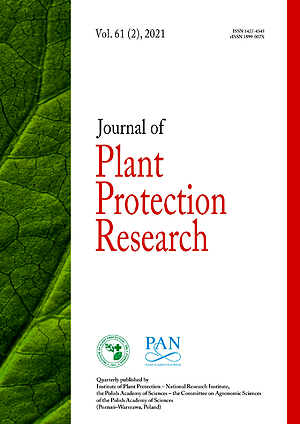ORIGINAL ARTICLE
Economic injury level of olive psyllid Euphyllura straminea Loginova (Hemiptera: Aphalaridae) in northwestern Iran
1
Plant Protection Department, Agricultural and Natural Resources Research Center of Zanjan Province (AREEO), Iran
2
Plant Protection Department, Agricultural and Natural Resources Research Center of Guilan Province, Rasht, Iran
A - Research concept and design; B - Collection and/or assembly of data; C - Data analysis and interpretation; D - Writing the article; E - Critical revision of the article; F - Final approval of article
Submission date: 2020-09-20
Acceptance date: 2020-12-23
Online publication date: 2021-06-19
Corresponding author
Aref Marouf
Plant Protection Department, Agricultural and Natural Resources Research Center of Zanjan Provinces (AREEO), 4533147183, Zanjan, Iran
Plant Protection Department, Agricultural and Natural Resources Research Center of Zanjan Provinces (AREEO), 4533147183, Zanjan, Iran
Journal of Plant Protection Research 2021;61(2):127-130
KEYWORDS
TOPICS
ABSTRACT
The olive psyllid Euphyllura straminea Loginova (Hemiptera: Aphalaridae) is one of the
most important pests of olive trees in Iran. To determine this pest’s economic injury level
(EIL) and to evaluate the relationship between density of nymphs (DON) and yield loss,
different densities of olive psyllid nymphs were maintained on olive trees by different insecticide
concentrations. Counting nymphs on olive terminal shoots was done to determine
nymph abundance at the end of nymphal stage. Different densities of olive psyllid
nymphs resulted in significantly different yield losses of olive trees. Regression analysis was
used to determine the relationship between nymph density and yield loss. Considering pest
management costs, the market value of olive, and insecticide efficiency, economic injury
levels were evaluated from 4.08 to 7.14 nymphal days. The olive psyllid EIL values could be
used to plan a pest control program in Zanjan and Guilan provinces.
FUNDING
This research was financially supported by the Agricultural
and Natural Resources Research Center of Zanjan
Province. Also, this work is the result of project No.
0-16-16-047-950253 of Agricultural Research, Education
& Extension Organization (AREEO) of Iran.
CONFLICT OF INTEREST
The authors have declared that no conflict of interests exist.
REFERENCES (18)
1.
Ahmadi K., Ebadzadeh H.R., Hatami F., Abdshah H. 2019. Agricultural Statistics. Vol. 3. Horticultural Production. Ministry of Jihad-e-Agriculture, Tehran, Iran (Islamic Republic of Iran), 159 pp. (in Persian).
2.
Anonymous. 2018. Olive Pest Management Guidelines. UC IPM Pest Management Guidelines. Available on: http://ipm.ucanr.edu/PMG/r5833.... [Accessed: 18 December, 2018].
3.
Chermiti B. 1992. An approach to the assessment of the harmfulness at the olive psyllid Euphyllura olivina Costa (Hom. Aphalaridae). Olivae 43: 34–42.
4.
Farahbakhsh Gh., Moini M. 1973. Olive Pests in Iran. Plant Pests and Diseases Research Institute, Tehran, Iran, 93 pp. (in Persian).
5.
Higley L.G., Pedigo L.P. 1996. Introduction to pest management and threshold. p. 3–9. In: “Economic Threshold for Integrated Pest Management” (L.G. Higley, L.P. Pedigo, eds.). University of Nebraska Press, USA, 327 pp.
6.
Keyhanian A., Taghaddosi M.V., Farzaneh A. 1995. Evaluation of olive psylla Euphyllura olivina Costa (Hom. Aphalaridae) ecology and identification of its natural enemies in Tarom Olya, north of Zanjan province. p. 191. In: Proceedings of 12th Iranian Plant Protection Congress, 2–7 September, Iran. (in Persian).
7.
Keyhanian A.A., Abbasi Mozhdehi M.R. 2018. Evaluation of processed kaolin clay (WP 95%) on reducing the population of olive psylla Euphyllura straminea Loginova (Hem. Psyllidae). Plant Protection 41 (2): 1–10. DOI: https://doi.org/10.22055/PPR.2....
8.
Mohiseni A.A., Zeinanloo A. 2000. The loss evaluation of olive psylla Euphyllura olivina Costa (Hom.; Aphalaridae). p. 274. In: Proceedings of 14th Iranian Plant Protection Congress. 5–8 September, Isfahan, Iran. (in Persian).
9.
Mustafa T.M. 1984. Factors affecting the distribution of Euphyllura olivina Costa (Hom., Psyllidae) on olive. Zeitschrift für Angewandte Entomologie 97: 371–375. DOI: https://doi.org/10.1111/j.1439....
10.
Mustafa T.M., Najjar Y.H. 1985. Contribution to the reproductive biology of olive psylla. Euphyllura olivina Costa. (Hom., Psyllidae). Zeitschrift für Angewandte Entomologie 100: 79–83. DOI: https://doi.org/10.1111/j.1439....
11.
Pala Y., Zimrsoglu A., Fidan U., Altin M. 1997. Recent integrated pest management studies in olive orchards in Turkey. Olivae 68: 37–38.
12.
Pedigo L.P. 1999. Entomology and Pest Management. 3rd ed. Prentice-Hall International, USA, 691 pp.
13.
Prophetou D.A., Tzanakakis M.E. 1976. Seasonal development and number of generation of Euphyllura olivina (Costa) in Halkidiki (N. Greece). Annals of the Entomological Society of America 70 (5): 707–709. DOI: https://doi.org/10.1093/aesa/7....
14.
Ruppel R.F. 1983. Cumulative insect-days as an index of crop protection. Journal of Economic Entomology 76 (2): 375–377. DOI: https://doi.org/10.1093/jee/76....
15.
Selim A.A., Swailem S.M., Amin A.H. 1981. Within-tree distribution and seasonal abundance of the olive psyllid, Euphyllura olivina (Costa) in the Mosul region of northern Iraq. Mesopotamia Journal of Agriculture 16 (1): 129–136.
16.
Talhouk A.S. 1969. Insect and Mite Injurious to Crops in Middle Eastern Countries. Hamburg and Berlin, Verlag Paul Pary, 239 pp.
17.
Talhouk A.S. 2002. Insect and Mite Injurious to Crops in Middle Eastern Countries. 2nd ed. American University of Beirut Press, Beirut, Lebanon, 269 pp.
18.
Tufekli M., Ulusoy M. 2011. Determination of the olive psyllid [Euphyllura straminea Loginova (Hemiptera: Psyllidae)] species, population dynamics in olive orchards in Adana and Mersin provinces (Turkey). Bitki Koruma Bulteni 51 (3): 215–230. (in Turkish).
Share
RELATED ARTICLE
We process personal data collected when visiting the website. The function of obtaining information about users and their behavior is carried out by voluntarily entered information in forms and saving cookies in end devices. Data, including cookies, are used to provide services, improve the user experience and to analyze the traffic in accordance with the Privacy policy. Data are also collected and processed by Google Analytics tool (more).
You can change cookies settings in your browser. Restricted use of cookies in the browser configuration may affect some functionalities of the website.
You can change cookies settings in your browser. Restricted use of cookies in the browser configuration may affect some functionalities of the website.




